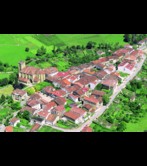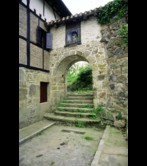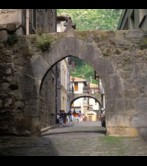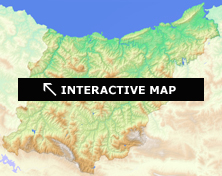Villas, an alternative model
A model with continuity
When the “villa” acquired legal status for certain communities this led to large-scale changes in the entire social, political and legal network of the inhabitants such that it formed the template for the organization of municipal areas in the 21st century. In a period of 200 years, Gipuzkoa went from not having a single villa to a network of 25 distributed more or less uniformly in an area of scarcely 2,000 km² and, most importantly, whose jurisdiction covered almost the entire region.
Those who organized themselves into a “villa” acquired certain advantages over their neighbours: military protection, their own laws, joint jurisdiction, a direct link to the crown, the recognition of equality among its members, and all of this within a well-defined territory. Beyond the villa, the Parientes Mayores continued to reign, although with diminishing power.
The new settlements were at the bottom of river valleys, where the majority of the cases still remain. They were built within walls which, as well as offering protection, served to demonstrate the strength and organization of the town.
Founding charter
The villas enjoyed their own system government, through a fuero or a founding charter which laid out the legal and administrative basis for the villa’s foundation and development. This document specifies a large number of situations and provisos: conditions necessary in order to qualify for public office or to live in the neighbourhood, commercial rights, punishment for infractions, tax exemptions, rights over woodland and other uses of the territory relating to duties or military requirements.
The fueros that extended across all the region that would later be Gipuzkoa were dominated by two big families: those from Jaca, who arrived from Estella and linked up with and expanded to Donostia, especially in coastal villas, and the family from Logroño, which arrived via Vitoria and which played a role in regulating the influence of the feudal lords in the villas. Using its original fuero as a basis, each villa developed its own norms and by-laws which reflect the interests and tensions of each one as it developed over time.
Distinct from the “vertical” power of the Parientes Mayores, the villa extolled neighborliness, the “horizontal” source of rights and duties. The villa’s members had full rights and came together in citizens assemblies known as “batzarrak”. To begin with these were open assemblies based on equality, however, they soon gave way to narrower bodies, a closed group, elected annually (to avoid interference from factions and the gradual development of certain urban elites).
The key representative of this group is clearly the mayor who is the main representative of the community and its military chief. His principal function is to judge, helped by councillors and other officials, depending on the locality.
Click on the following interactive map to obtain information about the foundation of the mediaeval villas in Gipuzkoa, the origin of their forums and their morphology and urban plan.
Activity
Although subsistence agriculture (cereals, vines etc.) continued, the main economic activity was artisanal production and trade. As well as supplying the fairly large local market, the iron from the nearby foundries was transformed into arms, nails, horseshoes and tools of all kinds for export, as well as textiles and trade with everything that came from Castile (mainly wool) or to Castile (cloth and other manufactured goods).
In coastal villas fishing, whale hunting and shipbuilding swelled the merchant shipping traffic between the peninsula and the rest of Western Europe. This is specially the case of San Sebastian.
Expansion
The success of this new urban model led to increasing interest from rural communities. The advantages enjoyed by these villas attracted other rural settlements, many of which ended up joining existing villas if they were unable to directly establish themselves through a founding charter.
In this manner, while the Crown initiated the first villas founded in the 12th and 13th centuries, in the 14th century it is rural settlements themselves that are asking for charters, in order to escape from the insecurity and pressure created by the Parientes Mayores. The foundation of Villareal de Urretxua is a good example of this process.





